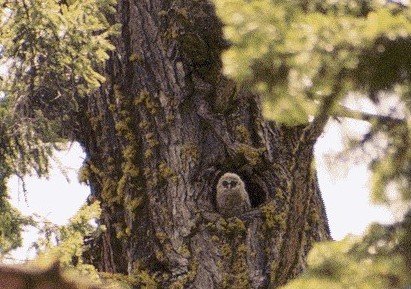What is in the new inventory of mature and old-growth forests?
Written by Joseph Vaile on April 26th, 2023
The US Forest Service and Bureau of Land Management (BLM) released the first ever national inventory of mature and old-growth forests.
Want to know what this all means for the protection of forests in the Pacific Northwest? Read on.
Why are older forests important?
A young northern spotted owl perched in a cavity of an old-growth tree.
For decades, wildlife ecologists, watershed scientists, and other experts have told us what we have all suspected: old-growth forests are special. Old forests are essential for wildlife, watershed protection and they inspire reverence. More recently we have come to realize that these forests also store carbon and are a key natural solution to climate change.
How much old forest did the inventory find?
The nation-wide inventory determined that while only 18% of the federal forest landscape contains old-growth forests, 45% contains mature forests. Mature forests can turn into old-growth if they are not logged or succumb to severe disturbance such as extreme wildfire.
What is included in the rulemaking?
In addition to an inventory, the announcement will also kick off an “advanced notice proposed rulemaking” that asks for input to create a rule addressing mature and old-growth forests. A rule could further direct the conservation and management of older forests across both BLM and US Forest Service lands.
What threats are there to old forests?
The agencies found that climate change, drought, and other stressors threaten older forests. While inappropriate management is mentioned as a threat, the agencies have been slow to acknowledge ongoing mature and old-growth timber sales. Instead, the focus is on management, such as fuels reduction, to reduce climate stress. They released an interactive “Climate Risk Viewer” that maps forest climate impacts.
Our Conservation Director, George, counted 365 rings on a downed log in a timber sale of southern Oregon’s old-growth forests.
Will the rule protect local forests from logging?
How the inventory and rulemaking will ultimately impact logging plans in mature and old-growth forests is unknown. Many local old-growth forests on BLM managed lands are threatened with logging. It is very important for the public to send a clear message to the Biden administration that we need strong protections from logging.
What about protecting forests that are currently threatened?
While the inventory and rule do not immediately offer protections for older forests, the U.S. Forest Service recommitted to ensuring that old-growth conservation is prioritized in upcoming forest management projects and sent direction to all field staff in the Forest Service. The BLM has not yet done so.
Please stay tuned to KS Wild Climate Program. We are tracking and engaging in this process every step of the way to ensure the strongest protection for old forests and trees and climate smart management of our forests into the future. Learn more about old-growth forests here.


